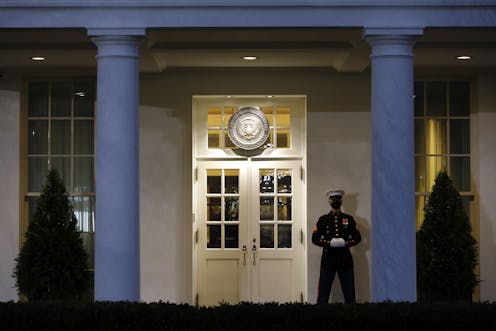After riots, Donald Trump leaves office with under 40% approval
- Written by Adrian Beaumont, Honorary Associate, School of Mathematics and Statistics, University of Melbourne

At 4am Thursday AEDT, Joe Biden and Kamala Harris will be inaugurated as president and vice president of the United States, replacing Donald Trump and Mike Pence. What follows is a discussion of US political events over the past two weeks.
On January 5, Democrats won the two Georgia Senate runoffs[1]. Raphael Warnock (D) defeated Kelly Loeffler (R) by 2.0%, and Jon Ossoff (D) defeated David Perdue (R) by 1.2%.
After November’s elections, Republicans held a 50-48 Senate lead, so these results enabled Democrats to tie the Senate at 50-50, with Harris to cast the tie-breaking vote. Democrats gained a net three Senate seats from the pre-November Senate.
On January 6, pro-Trump rioters stormed Congress as it met to certify Biden’s Electoral College victory. The rioters were clearly influenced by Trump’s baseless claims of election fraud. Despite the riots and the courts’ resounding rejections[2] of Trump’s claims, two state certifications were contested: Pennsylvania, which Biden won by 1.2%[3] and Arizona (Biden by 0.3%).
Seven Republican senators out of 51 objected to Pennsylvania’s certification, as did 138 Republicans[4] in the House of Representatives, with smaller numbers objecting to Arizona. The House objectors included House Republican leader Kevin McCarthy.
Just 64 House Republicans opposed the objection, so of those who cast a Yes/No vote on objecting to Pennsylvania, 68% supported the objection. Democrats were unanimously opposed.
It is not just Trump or the rioters, but also these Republicans in Congress who objected to the certifications on baseless election fraud claims who deserve to be condemned for anti-democratic behaviour.
I had two articles for The Poll Bludger about Georgia and the anti-democratic nuttiness of Trump and Republicans. The first was a preview[5], while the second was a live blog[6] on the Georgia results and the events in Congress the next day.
In response to the riots, on January 13 the Democrat-controlled House impeached Trump[7] for the second time by a 232-197 margin. All Democrats and ten Republicans supported impeachment. It requires a two-thirds majority in the Senate to convict. Trump’s Senate trial will not start until after he leaves office.
Since the riots, social media companies like Twitter and Facebook have blocked[8] Trump’s accounts. But for two months after the election result was called[9] by the media, Trump was able to use his Twitter account to rant that the election was stolen from him.
It is not surprising Trump’s supporters believe him: in a recent poll[10] for the US ABC News and the Washington Post, over 70% of Republicans do not believe Biden was legitimately elected.
In the wake of the riots, Trump’s ratings have slumped. In the FiveThirtyEight aggregate[11], 38.5% approve of Trump’s performance and 57.9% disapprove, for a net approval of -19.4%. His net approval has dropped nine points since the riots. Trump’s net approval is his worst since December 2017.
FiveThirtyEight has charts of presidential approval since Harry Truman (president from 1945-53). Two previous presidents (Gerald Ford and John F. Kennedy) did not reach Trump’s four years as president. Of those who had at least four years, Trump’s final net approval is worse than all except Jimmy Carter at this point in their terms.
In a Marist poll[12], 47% thought Trump would be remembered as one of the worst presidents, while 16% thought he would be remembered as one of the best.
After results are finalised, I have published a detailed report on every US presidential election since 2008. My 2008 and 2012 reports are at The Green Papers here[13] and here[14], and my 2016 report is at The Conversation[15]. My 2016 report had a massive surge in views in October and November last year.
My 2020 election report, published December 11, is at The Poll Bludger[16]. Here are the highlights:
Biden won the Electoral College by 306 to 232, but he only won the tipping-point state (Wisconsin) by 0.6%. The tipping-point state is the state that puts the winning candidate over the magic 270 Electoral Votes needed to win.
Biden won the national popular vote by 4.5% or just over 7 million votes. So the tipping-point state was 3.9% more pro-Trump than the popular vote.
Trump’s vote held up well with the non-University educated whites who had given him his upset 2016 win. Biden owed his Electoral College victory to gains in the suburbs, where there is a higher amount of university education.
Trump improved greatly from 2016 with Hispanics, leading to large swings in his favour in diverse places like Miami-Dade county, Florida and New York City.
There was disappointment for Democrats relative to expectations in Congressional races, although the Georgia runoff results have improved this.
References
- ^ Georgia Senate runoffs (www.nytimes.com)
- ^ resounding rejections (www.theguardian.com)
- ^ Biden won by 1.2% (cookpolitical.com)
- ^ 138 Republicans (clerk.house.gov)
- ^ preview (www.pollbludger.net)
- ^ live blog (www.pollbludger.net)
- ^ impeached Trump (clerk.house.gov)
- ^ have blocked (blog.twitter.com)
- ^ election result was called (theconversation.com)
- ^ recent poll (politicalwire.com)
- ^ FiveThirtyEight aggregate (projects.fivethirtyeight.com)
- ^ Marist poll (www.pbs.org)
- ^ here (www.thegreenpapers.com)
- ^ here (www.thegreenpapers.com)
- ^ The Conversation (theconversation.com)
- ^ The Poll Bludger (www.pollbludger.net)
Read more https://theconversation.com/after-riots-donald-trump-leaves-office-with-under-40-approval-153442













